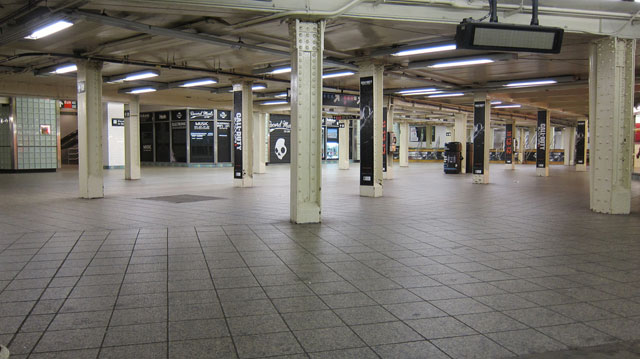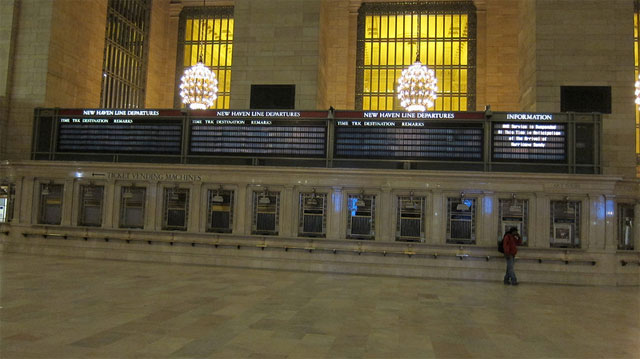Hurricane Sandy comin’
I don’t know how much I’m going to be updating this, but here’s a few things about the hurricane that’s bearing down on the East Coast right now. Mostly NYC centric.
Updated Sun 11:52pm ET:
The main hall of the closed Grand Central Terminal, deserted. Even stranger, the busiest subway station in NYC (Times Square), closed and deserted.

The Wind Map will likely be interesting over the next 36-48 hours. (via @panicstreak)
From Jeff Masters’ WunderBlog, a more technical view of the storm:
The National Weather Service in Upton, New York mentioned today that the predicted maximum water level of 11.7 feet at The Battery in New York City, which is expected to occur at 8:13pm ET on Monday, would break the record of 10.5 feet which was set on September 15, 1960 in Hurricane Donna.
The storm’s barometric pressure is going to be historically low:
Sandy should have sustained winds at hurricane force, 75 - 80 mph, at landfall. Sandy’s central pressure is expected to drop from its current 953 mb to 945 - 950 mb at landfall Monday night. A pressure this low is extremely rare; according to wunderground weather historian Christopher C. Burt, the lowest pressure ever measured anywhere in the U.S. north of Cape Hatteras, NC, is 946 mb (27.94”) measured at the Bellport Coast Guard Station on Long Island, NY on September 21, 1938 during the great “Long Island Express” hurricane.
Masters says that part of the NYC subway system may flood:
The full moon is on Monday, which means astronomical high tide will be about 5% higher than the average high tide for the month. This will add another 2 - 3” to water levels. Fortunately, Sandy is now predicted to make a fairly rapid approach to the coast, meaning that the peak storm surge will not affect the coast for multiple high tide cycles. Sandy’s storm surge will be capable of overtopping the flood walls in Manhattan, which are only five feet above mean sea level. On August 28, 2011, Tropical Storm Irene brought a storm surge of 4.13’ and a storm tide of 9.5’ above MLLW to Battery Park on the south side of Manhattan. The waters poured over the flood walls into Lower Manhattan, but came 8 - 12” shy of being able to flood the New York City subway system. According to the latest storm surge forecast for NYC from NHC, Sandy’s storm surge is expected to be at least a foot higher than Irene’s. If the peak surge arrives near Monday evening’s high tide at 9 pm EDT, a portion of New York City’s subway system could flood, resulting in billions of dollars in damage. I give a 50% chance that Sandy’s storm surge will end up flooding a portion of the New York City subway system.
But Linsey Lohan urges you not to panic:
WHY is everyone in SUCH a panic about hurricane (i’m calling it Sally)..? Stop projecting negativity! Think positive and pray for peace.
US financial markets were supposed to be open tomorrow but officials now have closed the markets on Monday.
Updated Sun 8:54pm ET:
The Day After Tomorrow, a movie directed by Roland Emmerich in which a super storm hits Manhattan, is available for streaming ($2.99) or to buy ($9.99) on Amazon Instant Video and on iTunes for sale ($12.99).
John Seabrook notes on Twitter:
Full moon at 7.50pm tomorrow, ten minutes before the high point of storm surge. Seems kind of biblical…
Or Mayan. 2012, y’all.
Justin reminds me of a classic New Yorker piece by Joe Morgenstern about a NYC skyscraper that was unprepared for hurricane-force winds.
On a warm June day in 1978, William J. LeMessurier, one of the nation’s leading structural engineers, received a phone call at his headquarters, in Cambridge, Massachusetts, from an engineering student in New Jersey. The young man, whose name has been lost in the swirl of subsequent events, said that his professor had assigned him to write a paper on the Citicorp tower, the slash-topped silver skyscraper that had become, on its completion in Manhattan the year before, the seventh-tallest building in the world.
LeMessurier found the subject hard to resist, even though the call caught him in the middle of a meeting. As a structural consultant to the architect Hugh Stubbins, Jr., he had designed the twenty-five-thousand-ton steel skeleton beneath the tower’s sleek aluminum skin. And, in a field where architects usually get all the credit, the engineer, then fifty-two, had won his own share of praise for the tower’s technical elegance and singular grace; indeed, earlier that year he had been elected to the National Academy of Engineering, the highest honor his profession bestows. Excusing himself from the meeting, LeMessurier asked his caller how he could help.
The student wondered about the columns—there are four—that held the building up. According to his professor, LeMessurier had put them in the wrong place.
“I was very nice to this young man,” LeMessurier recalls. “But I said, ‘Listen, I want you to tell your teacher that he doesn’t know what the hell he’s talking about, because he doesn’t know the problem that had to be solved.’ I promised to call back after my meeting and explain the whole thing.”
Updated Sun 8:22pm ET:
From the excellent coverage at WSJ:
Those living above the 10th floor in skyscrapers may want to find shelter in lower floors. Winds increase with height in a hurricane and could be significantly stronger than on ground level. Be cautious about sleeping near a window on Monday night. Do not walk outside on Monday evening, as there could be significant amounts of airborne debris flying around. Rain totals 4-8 inches.
Not a sight you see that often: Grand Central is closed.

From Quartz, a list of webcams to watch as Sandy approaches.
Updated Sun 8:11pm ET:
BREAKING NEWS! [siren] Powerful Storm Brings Down NY Times Paywall: “The Times is providing free unlimited access to storm coverage on nytimes.com and its mobile apps.”
From When There’s a Flood: if you’re preparing your house for a flood, shut off the water, propane, and electricity.
Just checked Uber in the West Village…about 10 cars less than three minutes away. Usually a lot less inventory than that.
Was rumored that MoMA would be open tomorrow with skeleton crew but word just now from their Twitter account: closed tomorrow.
From the NY Times:
If the surge runs as high as forecast, Con Ed will shut off two electrical networks in Lower Manhattan, known as the Fulton and Beekman networks, the official said.
I looked all over the place for a map that showed which parts of the city are served by the Fulton and Beekman but couldn’t find anything. I’m assuming the Fulton station is near the World Trade Center and the Beekman is on Beekman St by Pace University. So way Lower Manhattan?
Earlier:
Subway, bus and railroad services in New York and New Jersey are being shut down starting at 7pm tonight. Probably won’t be back open until sometime on Wednesday.
NYC schools are closed on Monday. And probably Tuesday. And if public transit is closed on Wed, schools with probably be closed that day too.
Taping your windows to protect them from hurricanes is “a waste of effort, time, and tape”.
Residents in Zone A in NYC have been ordered to evacuate. Check out where your zone is here.
New York City’s Hurricane brochure is available here.
The tracking map on Weather Underground gives you the opportunity to “share this storm”. Weather.com lets you see “friends at risk.” Uhh….
For storm updates in Spanish, be sure to follow Miguel Bloombito:
Did tu packo el vamos bag? No forgeto el casho, los medicatioño y tamponitos.
The WSJ has a great post comparing Sandy with Irene from last year. Sandy is much more potentially damaging in almost all respects.
On Saturday, Sandy became the largest storm in recorded Atlantic basin history, with a diameter of gale force winds of over 1000 miles. Tropical storm warnings were in place Saturday simultaneously for North Carolina and Bermuda, a sign of the storm’s massive geographic sweep. Those winds will follow Sandy northward, potentially encompassing more than 50 million people at once from Virginia to New England.
Peter Kafka paraphrasing Bloomberg: “don’t be stupid and it will be fine”.
Satellite view of Sandy from 2:42 am last night. Massive. This thing is Day After Tomorrow big.
Zones, evacuation centers, webcams, and more on this Google Maps maps.
Chad Dickerson notes that the decentralization of NYC’s stores is a plus:
the institution of the neighborhood corner store in NYC comes through for storm prep. decentralization ftw!





Stay Connected